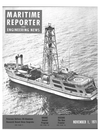
Page 55: of Maritime Reporter Magazine (November 1971)
Read this page in Pdf, Flash or Html5 edition of November 1971 Maritime Reporter Magazine
Bethlehem Delivers First
AML Full Containership
The Washington Mail after conversion and jumboizing to a full containership by the San Francisco shipyard of Bethlehem Steel Corporation.
The Washington Mail as the ship appeared prior to entering Bethlehem's shipyard.
The first of three Mariner-type cargo ves- sels to be jumboized and converted into full
C-6 containerships for American Mail Line was delivered recently Iby Bethlehem Steel
Corporation's San Francisco shipyard. The de- livery of the Washington Mail to her owners marked the completion of one of the largest containership conversions ever accomplished in the United States.
The Washington Mail, now 669 feet long, was lengthened 105 feet through the installa- tion of a new imid-body container cell section.
The ship's container-carrying capacity was ex- panded from 211 twenty-foot units to 892 twenty-foot containers or combinations of 20
The new 105-foot long mid-body section (top) is shown being floated into position during the conversion. This exacting maneuver occurred after the vessel had been cut in two and the bow section floated out into San
Francisco Bay (bottom). and 40 footers. The ship's deadweight was in- creased from 14,803 tons to about 20,000 tons.
The J J. Henry 'Co., Inc. prepared the con- version design and supervised the shipyard work for the owner. 'George G. Sharp, Inc. pre- pared the detailed construction plans for the shipyard.
In addition to the new mid-body, two new decks were added topside of the deckhouse and an 800-hp bow" thruster was installed for im- proved maneuverability in close quarters.
Bethlehem's conversion of the Washington
Mail and 'her two sisterships, the Japan Mail and Philippine Mail, is being carried out under a $25.5 million American Mail Line-U.S. Mari- time Administration joint contract.
The original passenger quarters were rear- ranged during the conversion so that the spaces added by the additional decks in the house would be utilized. The all new air-conditioned luxury quarters for 12 passengers include spacious staterooms, an upper Observation lounge, dining room, exercise room and library.
Another feature of the ship's conversion is the addition of a third turbo-generator, rated at 875 kw, to handle the increased loads and refrigerated containers. The vessel as a C-4
Mariner had only two 700-kw turbo-generators.
The wheelhouse was relocated on the high- est of the two new decks to provide better visibility. Automated main-engine control from the bridge also has been provided. In order to strengthen the vessel to accommodate its greater length and to provide the maximum width for container holds, the conversion fur- ther entailed the installation Of six foot wide, nine foot deep box girders on each side of the extended hull. The girders are 489 feet long, nearly three-fourths the length of the ship.
To provide added deck space for containers and room for the possible installation of load- ing cranes, a 70 foot long sponson was built along each side of the vessel at the bow and stern.
The Washington Mail entered the Bethle- hem yard about nine months ago. The ship's new mid-body section was launched January 22, 1971. At that time, the vessel was placed stern-in on the yard's new 65,000-ton capacity floating 'dry dock and cut in two just forward of her deckhouse.
The bow was floated out into the bay while the ship's new mid-body was towed into the dock and welded to the stern portion of the vessel. Then, the bow was brought back into the dry dock and joined to the new mid-bcdy, thus completing the ship's lengthening from 564 feet to 669 feet.
The new mid-body, built at Bethlehem's San
Francisco yard, weighs 1,200 tons. In addition to container cells, it is fitted with wing tanks for fuel oil. A total of more than 4,000 tons of new steel was utilized to containerize the ship.
Conversion of her two sisterships is pro- ceeding in the same manner, with the Japan
Mail scheduled for delivery this month and the
Philippine Mail early next year.
AML Planning
Robert E. Benedict, American Mail Line's president, recently announced plans involving the addition of a fourth C-6 containership, a near 60 percent increase in the number of year- ly voyages and a dramatic change in the line's service pattern.
With the addition of a fourth converted Ma- riner-type ship to a full containership, Ameri- can Mail Line will have embarked on a $45.8 million program. Of this amount, American
Mail Line will spend $10.6 million for contain- ers and $35.2 million for the conversions. The
U.S. Government share for construction sub- sidies is $13.4 million.
The new operating plan calls for operating the containerships in an express service with weekly sailings between the Pacific Northwest and the Japanese ports of Yokohama, Kobe and Nagoya. The line's semi-container vessels will operate between the Pacific Northwest and Korea, Hong Kong, Vietnam, Singapore,
Malaysia and Taiwan, with twice-monthly service. The remaining C-4 Mariners will be used on the company's extended area route to
Southeast Asia and the Bay of Bengal.
November 1, 1971 55

 54
54

 56
56
